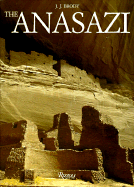
|
|

|

|

|
|

Tilattavissa olevat kirjat: The Anasazi


Kirjan nimi: The Anasazi
Tekijä: Brody, J. J.
Sivumäärä: 239
Kieli:  Englanti Englanti
Ilmestymisvuosi: 1990
ISBN: 0847812081
Hinta: 39.80 €
Sidosasu: Sidottu
Sisällön kuvaus:
The Anasazi were located in the Four Corners region ( Northern New Mexico west of the Pecos River, southwestern Colorado, most of southern Utah, and northern Arizona south to the Little Colorado River). The Anasazi existed around two thousand years ago and are thought to be the ancestors of modern Indian tribes like the Hopi, the Zuni and the Pueblo. The earliest Anasazi probably settled in the plateau area because water was more available. They settled into three distinct population centers which were Chaco Canyon, Mesa Verde, and Kayenta and eventually spread out across the entire plateau. The Anasazi tradition can be divided into two parts: the Basket Makers and the Pueblo.Paleo-Indian and Archaic people hunted and foraged in the canyon. Semi-permanent hunter-gatherers began cultivating squash and corn in the first millennium. Finally in AD 490, the first permanent villages were established due to an increase in annual rainfall. Around AD 1050, the communities of Chaco Canyon were at the peak of their activity. During this time there was trade of foods and other goods. The Anasazi had a diet of garden corn, squash, beans, gathered foods and hunted game. Because so much time and effort was spent feeding themselves, they focused very little on permanent homemaking. They originally opted to spend only the coldest months under shelter. As time progressed, however, more and more houses were built. What they assembled for living quarters was a circular frame from ten to twenty-five feet in diameter. Surface sand was scooped away in a bowl-like structure with a place for a fire in the middle. The walls were logs stacked on each other and the entire structure narrowed at the top. Instead of a complete roof, they left a hole at the top to let out the smoke which would rise from the fire. The walls were then covered with mud to seal up the cracks. These structures are known as kivas. The Anasazi also used caves. Occasionally these caves would be used for living space, but their main purpose was for the storage of dried food. Around 700 A.D., the Anasazi began a period of transition and advancement that changed them from the Basket Maker Anasazi to the Pueblo Anasazi. Pueblo was the name of the new building technique they were using. Around 1000 AD, masonry houses were being built with stones stacked on top of each other and mud being used for mortar. They began to build impressive dwellings, becoming expert stone masons. They increased the frequency and design of pottery making and discovered the use of the bow and arrow. By 1200 AD, village locations were being picked in spots that were safer and harder to attack indicating that war and violence were increasing. After that, for reasons largely unexplained, the Anasazi began leaving their homes and by 1300A.D, the Anasazi had disappeared.
  |  |
|
|

|
|

|